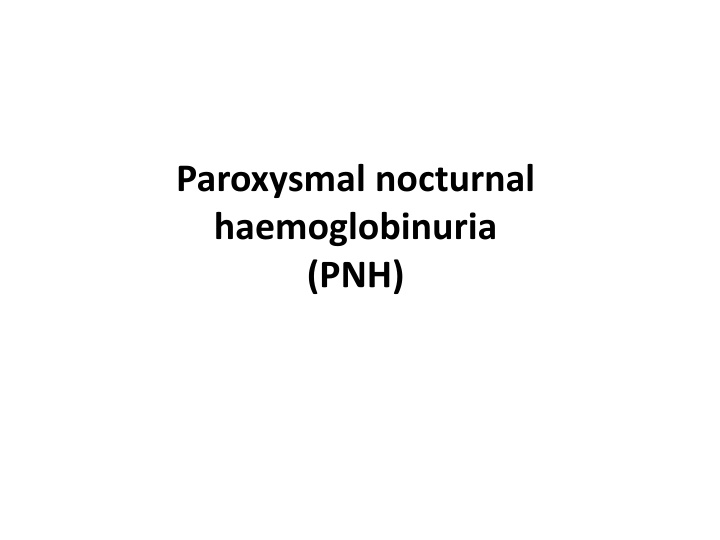
Paroxysmal Nocturnal Haemoglobinuria (PNH)
Paroxysmal Nocturnal Haemoglobinuria (PNH) is a rare acquired disorder characterized by deficient synthesis of the GPI anchor, leading to chronic intravascular haemolysis, venous thrombosis, and bone marrow failure. Mutations in the X chromosome gene PIG.A result in the absence of GPI-linked proteins like CD55 and CD59, rendering red cells sensitive to complement-mediated lysis. PNH is also associated with haemosiderinuria, iron deficiency, and venous thrombosis, often accompanied by bone marrow hypoplasia. Learn more about the clinical manifestations, diagnostic challenges, and management of PNH.
Download Presentation

Please find below an Image/Link to download the presentation.
The content on the website is provided AS IS for your information and personal use only. It may not be sold, licensed, or shared on other websites without obtaining consent from the author. If you encounter any issues during the download, it is possible that the publisher has removed the file from their server.
You are allowed to download the files provided on this website for personal or commercial use, subject to the condition that they are used lawfully. All files are the property of their respective owners.
The content on the website is provided AS IS for your information and personal use only. It may not be sold, licensed, or shared on other websites without obtaining consent from the author.
E N D
Presentation Transcript
Paroxysmal nocturnal haemoglobinuria (PNH)
PNH is a rare, acquired, clonal disorder of marrow stem cells in which there is deficient synthesis of the glycosyl-phosphatidyl- inositol(GPI) anchor, a structure that attaches several surface proteins to the cell membrane. There is a clinical triad of chronic intravascular haemolysis, venous thrombosis and bone marrow failure
It results from acquired mutations in the X chromosome gene coding for phosphatidylinositol glycan protein class A (PIG A), which is essential for the formation of the GPI anchor. The net result is that GPI linked proteins (such as CD55 and CD59) are absent from the cell surface of all the cells derived from the abnormal stem cell
CD55 and CD59 are also normally present on white cells and platelets. The lack of the surface molecules decay activating factor (DAF, CD55) and membrane inhibitor of reactive lysis (MIRL, CD59) render red cells sensitive to lysis by complement and the result is chronic intravascular haemolysis.
Haemosiderinuria is a constant feature and can give rise to iron deficiency which may exacerbate the anaemia. Haptoglobins are absent; free haemoglobin may damage the kidney and it removes nitric oxide from smooth muscle causing dysphagia and pulmonary hypertension.
The other main clinical problem in PNH is of venous thrombosis. Patients may develop recurrent thromboses of large vessels, including the portal, hepatic and mesenteric veins. Arterial thrombosis, such as strokes or myocardial infarction, can also occur. Intermittent abdominal pain due to mesenteric vein thrombosis is a common feature
PNH is almost invariably associated with some form of bone marrow hypoplasia and there may even be complete aplastic anaemia. It appears that the PNH clone may expand as a result of a selective pressure, possibly immunologically mediated, against cells that have normal GPI linked membrane proteins
PNH is diagnosed by flow cytometry which shows loss of expression of the GPI linked proteins CD55 and CD59. This has replaced the demonstration of red cell lysis in serum at low pH the Ham test.
Eculizumab, a humanized antibody against complement C5, inhibits the activation of terminal components of complement and reduces haemolysis, transfusion requirements and the incidence of thrombosis. Iron therapy is used for iron deficiency and long term anticoagulation with warfarin may be needed. Immunosuppression can be useful and allogeneic stem cell transplantation is a definitive treatment. The disease occasionally remits spontaneously. The median survival is over 10 years. As for aplastic anaemia, transformation to MDS or AML may occur.
Chronic form This is a rare syndrome characterized by anaemia with normal leucocytes and platelets and grossly reduced or absent erythroblasts in the marrow The congenital form is known as Diamond Blackfan syndrome
inherited as a recessive condition. It is associated with a varying number of somatic abnormalities (e.g. of the face or heart). Mutation of a gene on chromosome 19 or other genes that encode ribosomal proteins underlies most cases
Corticosteroids are the first line of treatment and SCT may be curative. Androgens may also produce improvement but sideeffects on growth can be severe. Iron chelation is needed after multiple transfusions
The acquired chronic can occur without any obvious associated disease or precipitating factor (idiopathic), or may be seen with autoimmune diseases (especially systemic lupus erythematosus), with a thymoma, lymphoma or chronic lymphocytic leukaemia.
In some cases, immunosuppression with corticosteroids, rituximab, ciclosporin, azathioprine or ATG is helpful. Monoclonal antibodies, such as rituximab (anti CD20), are being used increasingly in treatment of refractory acquired red cell aplasia and other autoimmune cytopenias. If regular blood transfusions are needed, iron chelation therapy will also be necessary. SCT has been carried out in some severe cases
Transient form Parvovirus B19 infects red cell precursors via the P antigen and causes a transient (5 10 days) red cell aplasia. This can result in rapid onset of severe anaemia in patients with pre existing shortened red cell survival, such as those with sickle cell disease or hereditary spherocytosis (Fig. 22.7 Transient red cell aplasia with anaemia may also occur in association with drug therapy and in normal infants or children, often with a history of a viral infection in the preceding 3 months
Congenital dyserythropoietic anaemia are a group of hereditary refractory anaemias characterized by ineffective erythropoiesis and erythroblast multinuclearity. The patient may be jaundiced with bone marrow expansion. The white cell and platelet counts are normal. The reticulocyte count is low for the degree of anaemia, despite increased marrow cellularity. The anaemia is of variable severity and is usually first noted in infancy or childhood Iron overload may develop and splenomegaly is common
In 1968Wendt and Heimpel classified CDA into three types (I, II and III) (Table 10.9).Over the yearsmany additional subtypes (IV, V, VI and VII) have been added to the list, often based on case reports.
CDA type I The majority of patients present with splenomegaly and mild to moderate anaemia ( 66 116 g/L); approximately 70% have macrocytosis. In some cases non-haematological features (e.g. skeletal abnormalities, abnormal skin pigmentation) have been observed. Ineffective erythropoiesis is evidenced by morphological abnormalities in the peripheral blood (anisocytosis) and in the marrow (megaloblastic erythroid precursors, internuclear chromatin bridging, binuclearity affecting 3 7% of erythroblasts; as well as by increased markers of haemolysis (elevated lactate dehydrogenase and bilirubin). The defining ultrastructural feature is a spongy ( Swiss cheese ) appearance of the heterochromatin in themajority of erythroblasts on electron microscopy . Recognized to be AR, the first gene responsible for CDA type I (CDAN1, called codanin) was identified in 2002. Recently a second gene, C15ORF41, was found to be responsible for some cases of CDA type I.
CDA type II This is the most common subtype of CDA and was initially described as hereditary erythroblastic multinuclearity with a positive acidified serum lysis test (HEMPAS) in 1969. It is inherited as an AR trait. The anaemia is variable (Hb 80 110 g/L). Approximately 10% of cases require regular transfusions and some cases present with anaemia at birth. The clinical presentations include a variable degree of jaundice, hepatomegaly, splenomegaly and cirrhosis. Mental retardation has been reported in some cases. Peripheral blood morphology shows moderate to marked red cell anisocytosis. BM features include normoblastic erythroid hyperplasiawith usuallymore than 10%binucleate erythroblasts
At the electron microscope level, the erythroid cells have a characteristic peripheral arrangement of the endoplasmic reticulumgiving the appearance of a doublemembrane Red cells from patients with CDA type II are haemolysed by some acidified sera, but not by the patient s own serum. In 2009 the gene encoding the secretory COPII component SEC23B was shown to be responsible for CDAII
CDA type III This subtype is rare. In one of the largest (Swedish) families investigated, the disease was characterized by giant multinucleated erythroblasts in the marrow . There appears to be an increased prevalence of lymphoproliferative disorders in CDA type III. CDA III exhibits AD transmission and is caused by mutations in KIF23. KIF23 encodes mitotic kinesin-like protein 1, which plays a critical role in cytokinesis during cell division.
Osteopetrosis This is a rare heterogeneous group of disorders due to failure of bone resorption by osteoclasts. Inheritance may be recessive or dominant. The bones are dense but brittle and fractures are common. The marrow space is reduced and a leucoerythroblastic anaemia occurs. The liver and spleen are enlarged. Early death from the consequences of bone marrow failure is usual. SCT offers a chance of cure.






















